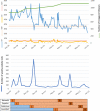The effect of a locally tailored intervention on the uptake of preconception care in the Netherlands: a stepped-wedge cluster randomized trial (APROPOS-II study)
- PMID: 36319990
- PMCID: PMC9623982
- DOI: 10.1186/s12889-022-14343-x
The effect of a locally tailored intervention on the uptake of preconception care in the Netherlands: a stepped-wedge cluster randomized trial (APROPOS-II study)
Abstract
Background: The preconception period provides a window of opportunity for interventions aiming to reduce unhealthy lifestyle behaviours and their negative effect on pregnancy outcomes. This study aimed to assess the effectiveness of a locally tailored preconception care (PCC) intervention in a hybrid-II effectiveness implementation design.
Methods: A stepped-wedge cluster randomized controlled trial was performed in four Dutch municipalities. The intervention contained a social marketing strategy aiming to improve the uptake (prospective parents) and the provision (healthcare providers) of PCC. Prospective parents participated by administering a questionnaire in early pregnancy recalling their preconceptional behaviours. Experiences of healthcare providers were also evaluated through questionnaires. The composite primary outcome was adherence to at least three out of four preconceptional lifestyle recommendations (early initiation of folic acid supplements, healthy nutrition, no smoking or alcohol use). Secondary outcomes were preconceptional lifestyle behaviour change, (online) reach of the intervention and improved knowledge among healthcare providers.
Results: A total of 850 women and 154 men participated in the control phase and 213 women and 39 men in the intervention phase. The composite primary outcome significantly improved among women participating in the municipality where the reach of the intervention was highest (Relative Risk (RR) 1.57 (95% Confidence Interval (CI) 1.11-2.22). Among women, vegetable intake had significantly improved in the intervention phase (RR 1.82 (95%CI 1.14-2.91)). The aimed online reach- and engagement rate of the intervention was achieved most of the time. Also, after the intervention, more healthcare providers were aware of PCC-risk factors (54.5% vs. 47.7%; p = 0.040) and more healthcare providers considered it easier to start a conversation about PCC (75.0% vs. 47.9%; p = 0.030).
Conclusion: The intervention showed some tentative positive effects on lifestyle behaviours among prospective parents. Primarily on vegetable intake and the knowledge and competence of healthcare providers. The results of this study contribute to the evidence regarding successfully implementing PCC-interventions to optimize the health of prospective parents and future generations.
Trial registration: Dutch Trial Register: NL7784 (Registered 06/06/2019).
Keywords: Health promotion; Lifestyle Behaviour; Preconception care; Social marketing.
© 2022. The Author(s).
Conflict of interest statement
All authors declare that they have no competing interests.
Figures




References
-
- Sidhu S. Surviving birth: every 11 seconds, a pregnant woman or newborn dies somewhere around the world. UNICEF; 2019. Available: https://www.unicef.org/press-releases/surviving-birth-every-11-seconds-p....
-
- de Weerd S, Steegers EA. The past and present practices and continuing controversies of preconception care. Community Genet. 2002;5(1):50–60. - PubMed
Publication types
MeSH terms
LinkOut - more resources
Full Text Sources
Medical

